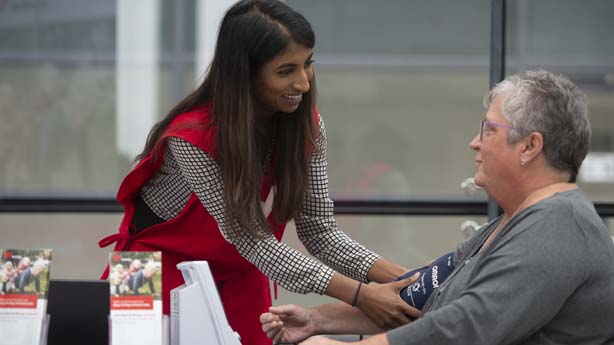Keep your blood pressure in check
High blood pressure is the number one risk factor for stroke and a major risk factor for heart disease. High blood pressure is when the blood pressure in your arteries rises and your heart has to work harder than normal to pump blood through the blood vessels. It is important that you have your blood pressure checked regularly by your healthcare provider.
What is blood pressure?
Blood pressure is a measure of the pressure or force of blood against the walls of your blood vessels (arteries). Your blood pressure reading is based on two measures. The top number (systolic) is the measure of the pressure when your heart contracts and pushes blood through the arteries. The bottom (diastolic) number is the measure of the pressure when your heart relaxes between beats.
There are three different blood pressure categories: low risk, medium risk, high risk. See your doctor or healthcare provider to get a proper blood pressure measurement and find out which category you are in.
Blood pressure categories
Category
Systolic/Diastolic
Low risk
120 / 80
Medium risk
121-134 / 80-84
High risk
135+ /85+
There are some exceptions to these categories.
If you have diabetes, the high risk category for your blood pressure is slightly lower. Your blood pressure should be less than 130 / 80. Consult a healthcare provider if your blood pressure level is higher than 130 / 80 on more than one occasion.
What is low blood pressure?
Low blood pressure (hypotension) is when the pressure in your arteries drops below the normal range. But blood pressure levels below 120 / 80 may be normal for some people. Your healthcare provider will tell you if you have low blood pressure.

How do I check my blood pressure?
Ask your doctor or other healthcare provider to check your blood pressure. If you are diagnosed with high blood pressure (or other related conditions), be sure to ask your doctor how often you should have your blood pressure checked.
Scroll down for a video on how to measure your own blood pressure.
What should I do if I have a high blood pressure reading?
If you have one high reading, you should have it checked at least two more times on separate days to determine if it is consistently high.
Keep a record of your blood pressure readings on a blood pressure tracking card or app. This record will help determine whether your blood pressure is within a healthy range.
What can I do to control my blood pressure?
High blood pressure can be caused by many factors. You can't control some risk factors, such as age, ethnicity and gender. Other factors, such as diet, exercise and smoking can be addressed through lifestyle changes to reduce your risk for high blood pressure.
After 65, women are more likely than men to get high blood pressure. Throughout a woman’s life, factors like pregnancy, birth control and menopause can increase the risk of developing high blood pressure.
Here is what you can do:
- Have your blood pressure checked regularly as recommended by your healthcare provider.
- If your doctor has prescribed medication for hypertension, take it as directed. Follow these links to more information about medications for hypertension and heart disease or hypertension and stroke.
- Reduce the amount of salt you eat. High sources of sodium are found in highly processed foods. This includes fast foods, prepared meals, processed meats (such as hot dogs and lunch meats), canned and dried soups, bottled dressing, packaged sauces, condiments and salty snacks. Also try to limit your use of salt in cooking and at the table. Heart & Stroke recommends that Canadians eat less than 2,300 mg of sodium (about 1 tsp / 5 mL of salt) a day total from processed foods and salt added during food preparation and at the table. If you have high blood pressure, the recommendation is to eat less than 2000 mg of sodium per day.
- Eat foods high in potassium such as fresh fruits, vegetables, low-fat dairy foods, beans and lentils - unless you are taking a medication that interacts with potassium.
- Eat a healthy, balanced diet that is lower in salt and saturated fat. Get tips on healthy eating and learn more about the DASH eating plan, which can help lower your high blood pressure and the Mediterranean diet.
- Be physically active for at least 150 minutes per week doing moderate- to vigorous-intensity aerobic physical activity, in bouts of 10 minutes or more. Speak to your healthcare provider before starting a physical activity program.
- Achieve and maintain a healthy body weight. If you are overweight, losing even 5% to 10% of your weight can help to reduce your blood pressure as well as decrease your chances of having a stroke or heart attack.
- Be smoke-free. If you smoke, speak to your doctor or healthcare provider about quitting. If you don't smoke, minimize exposure to secondhand smoke.
- If you drink alcohol, drink less. Limit yourself to small amounts, pace yourself and drink plenty of water in between.
- Find healthy ways to manage your stress. Too much stress may increase your blood pressure. Research suggests that the way in which you manage your stress is very important. Avoid unhealthy coping mechanisms such as smoking, alcohol use, poor food choices, not being active, and watching too much television. Find relief instead with physical activity, socializing, laughter and healthy eating. Remember to take time out for yourself. Get tips on relaxation and mindfulness from people who are living with heart disease and stroke.
Measuring your blood pressure at home
Home monitoring can help your doctor to diagnose your blood pressure correctly. It is possible for your blood pressure to rise when you visit the doctor's office because you may be anxious. However, your blood pressure can return to normal as you go about your daily activities. This is called “white coat effect.” Measuring your own blood pressure regularly can help you determine if your blood pressure is in fact high.
On the other hand, you may experience normal blood pressure when it is measured in the doctor's office, but have high blood pressure in other situations. This is known as “masked hypertension.” If you have a higher risk of heart disease or stroke (e.g. if you have diabetes), it is important to find out if you have masked hypertension. If this is the case, your doctor may ask you to monitor your blood pressure at home.
It is important to make sure that your home monitor is taking accurate measurements so your healthcare provider can get a complete picture of your blood pressure.
Follow these steps to get the most accurate reading:
- Do not smoke or drink caffeine (coffee, tea, cola and some sports drinks) for 30 minutes beforehand.
- Do not measure your blood pressure when you are upset or in pain.
- Empty your bladder or bowel, if necessary.
- Sit quietly with your feet flat on the floor and back resting against the back of a chair or a firm surface for at least 5 minutes before measuring and during measurement.
- Use the same arm each time. Remove bulky or tight clothing from your arm completely.
- Wrap the cuff snugly around your bare upper arm (2 fingers should fit between the blood pressure cuff and your arm). The edge of the cuff must be 3cm above your elbow.
- Place your arm on a table or a firm surface. The cuff must be at the level of your heart.
- Do not talk or watch TV during the test.
- Take one reading and record your blood pressure.
- Bring a record of your readings to your next appointment with your healthcare provider.
How to buy a home blood pressure monitor
Your doctor or pharmacist can help you choose a monitor and select a cuff size that is right for you.
Heart & Stroke suggests that the unit be automated instead of manual. If you have an irregular heart rhythm some devices may not be advised for you. Select a device recommended by Hypertension Canada.
Once you have purchased a home monitor, take it to your healthcare provider’s office once or twice a year to make sure it continues to give accurate readings.
Related information
Managing your blood pressure (20 pages)
The Beat: Confronting the silent killer (podcast)
Home blood pressure log from Hypertension Canada
